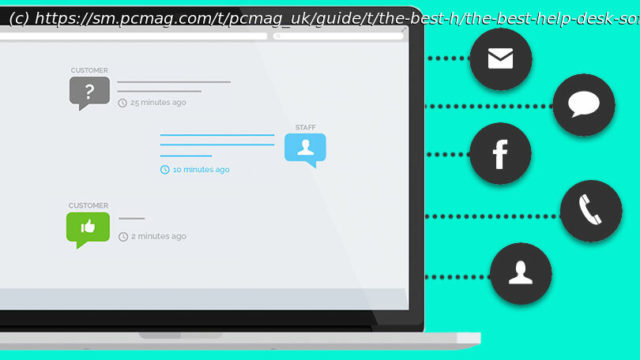Whether your company needs to offer customer support or just handle internal IT requests, a help desk system is essential for streamlining those processes. We test and compare the top contenders.
Much has changed for help desk staffers in just the past three years. In the wake of the pandemic, retailers saw in-store visits plummet as customers went online for their purchases, and multiple surveys have shown that many consumers say they now prefer shopping this way than in person. According to research by McKinsey & Company, the number of consumers who purchase online is up 15–30% for most product categories. As a result, the volume of requests for returns, warranty service, and post-purchase support that are handled by remote help desks is snowballing. Similarly, even before the pandemic, businesses had increasingly begun embracing remote work and hybrid work models. Many now say they plan to make these policies permanent, meaning those employees can expect to have their IT support requests handled by the help desk, rather than an in-person visit, for the foreseeable future. All of this points to what we already knew; that good help desk software is essential for businesses of all sizes. But what kind do you need? Do you need a platform that adheres to ITIL ( Information Technology Infrastructure Library)? Do you need to support multiple communications channels, such as social media? Perhaps you’re looking to reduce your support staff’s workload by augmenting them with chatbots and even AI? All this and more is possible. Read on to learn what you’ll need to consider before you buy. What Help Desk Software Does Help desk software is the heartbeat of a well-run help desk. It’s one of a company’s top priorities, whether it is a small to midsize business (SMB) or a large organization. At the core, help desk solutions generally revolve around what’s called a ticketing system. « Ticketing » refers to how requests from customers or users reach service reps, most often as « trouble tickets. ». No matter which channel your customer uses, any complaint gets put into a ticket format that contains all its basic information. That will include a problem summary, the customer ID, the time reported, the channel used, and which service rep was assigned to work on it. How a system manages these tickets is the primary differentiator between help desk solutions. There is no shortage of options in this space. Help desk software is available that caters to various general and specialized use cases, including not just SMBs but also larger organizations and internal IT teams that don’t handle customer requests. Given all the players, you’ll find that not all help desk software will be equal. But what’ll differentiate one solution over another will often be dependent on your business’s individual needs, rather than technology or product quality. For example, help desk software such as Freshdesk or Zendesk Support includes social tie-ins that let tickets be raised from social media websites such as Twitter. This could be an important feature to a company that deals with a large customer base, but not necessarily for one that just needs an internal IT service platform. Other help desk software, such as Jira Service Desk, provides additional security measures and identity management (primarily single sign-on or SSO) features, which may be key differentiators to some companies. SSO offers users the ability to create one set of log-in credentials for multiple applications. Understanding the ITIL Framework As we touched upon earlier, certain organizations will want to be sure their help desk aligns with the Information Technology Infrastructure Library (ITIL), an established service framework used mainly by IT management companies or those managing large custom software development projects. It’s a set of best practices that incorporate checklists, procedures, processes, and tasks designed to make such scenarios more structured and efficient. Each help desk system we tested here broadly falls into one of two camps: those that follow ITIL’s guidelines and those that don’t. A few years ago, you might have said that the more feature-advanced solutions are the ones that follow ITIL, such as Editors’ Choice winners Freshservice and HaloITSM, as well as Jira Service Management and ManageEngine ServiceDesk Plus 9.3. Things have changed a bit today, however. ITIL support is less about more advanced capabilities now and more about the product’s focus. Internal service desks aimed at managing enterprise data centers or large custom development projects will still adhere to ITIL. But ITIL isn’t the best bet for companies looking to support products and customers. That’s not to say that platforms targeting these use cases don’t necessarily have a less advanced feature set than ITIL-oriented platforms; they simply have different goals. So, for example, if you are a software developer looking for something to handle incoming support requests from customers, then strong change management (something ITIL governs) probably isn’t something you need. Also, businesses that don’t adhere to ITILwill probably focus more on initiating trouble tickets via channels other than email, especially social media. If you’re in one of those organizations, look at the customer- and marketing-related features found in platforms like Editors’ Choice winners Freshdesk and HappyFox. The Latest: Talkin’ About Bots When they were first introduced, Chatbots made a huge splash in the customer service sector. These increasingly sophisticated software services can often take over, or at least augment, the live-chat capability of your support website. Customers who engage with a chatbot often believe they’re discussing their issues with a real person, when in fact they’re chatting with a rule-based program that uses detailed questions and natural language query processing to find out what the problem is. If possible, the chatbot resolves the issue by giving a canned answer to a common problem, a display of alternate information resources, or triggering an automated process. Contact routing is another important function of most chatbots. If the bot can’t solve a problem, it hands the customer off to an actual person, ideally one armed with specific domain knowledge. It can even route the customer to the right service representative based on the rep’s past experience with similar issues. Sometimes the customers know about the handoff, but sometimes they’re left none the wiser.






